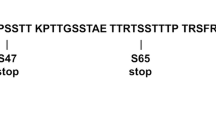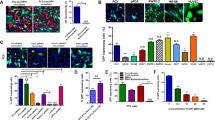Abstract
Fusogenic membrane glycoproteins (FMGs) may enhance the cytotoxicity of conditionally replicative adenoviruses. However, expression at early stages of infection impairs virus replication. We have inserted the hyperfusogenic form of the gibbon ape leukemia virus (GALV) envelope glycoprotein as a new splice unit of the major late promoter (MLP) to generate a replication-competent adenovirus expressing this protein. At high multiplicity of infection (MOI), this virus replicated efficiently forming clumps of fused cells and showing a faster release. In contrast, at low MOI, infected cells formed syncytia where only one nucleus contained virus DNA, decreasing total virus production but increasing cytotoxicity.
This is a preview of subscription content, access via your institution
Access options
Subscribe to this journal
Receive 12 print issues and online access
$259.00 per year
only $21.58 per issue
Buy this article
- Purchase on Springer Link
- Instant access to full article PDF
Prices may be subject to local taxes which are calculated during checkout




Similar content being viewed by others
References
Alemany R, Balague C, Curiel DT . Replicative adenoviruses for cancer therapy. Nat Biotechnol 2000; 18: 723–727.
Nemunaitis J, Ganly I, Khuri F, Arseneau J, Kuhn J, McCarty T et al. Selective replication and oncolysis in p53 mutant tumors with ONYX-015, an E1B-55kD gene-deleted adenovirus, in patients with advanced head and neck cancer: a phase II trial. Cancer Res 2000; 60: 6359–6366.
Vecil GG, Lang FF . Clinical trials of adenoviruses in brain tumors: a review of Ad-p53 and oncolytic adenoviruses. J Neurooncol 2003; 65: 237–246.
Li H, Haviv YS, Derdeyn CA, Lam J, Coolidge C, Hunter E et al. Human immunodeficiency virus type 1-mediated syncytium formation is compatible with adenovirus replication and facilitates efficient dispersion of viral gene products and de novo-synthesized virus particles. Hum Gene Ther 2001; 12: 2155–2165.
Sauthoff H, Pipiya T, Heitner S, Chen S, Norman RG, Rom WN et al. Late expression of p53 from a replicating adenovirus improves tumor cell killing and is more tumor cell specific than expression of the adenoviral death protein. Hum Gene Ther 2002; 13: 1859–1871.
Ahmed A, Jevremovic D, Suzuki K, Kottke T, Thompson J, Emery S et al. Intratumoral expression of a fusogenic membrane glycoprotein enhances the efficacy of replicating adenovirus therapy. Gene Therapy 2003; 10: 1663–1671.
Cascante A, Abate-Daga D, Garcia-Rodriguez L, Gonzalez JR, Alemany R, Fillat C . GCV modulates the antitumoural efficacy of a replicative adenovirus expressing the Tat8-TK as a late gene in a pancreatic tumour model. Gene Therapy 2007; 14: 1471–1480.
Bateman A, Bullough F, Murphy S, Emiliusen L, Lavillette D, Cosset FL et al. Fusogenic membrane glycoproteins as a novel class of genes for the local and immune-mediated control of tumor growth. Cancer Res 2000; 60: 1492–1497.
Fielding AK, Chapel-Fernandes S, Chadwick MP, Bullough FJ, Cosset FL, Russell SJ . A hyperfusogenic gibbon ape leukemia envelope glycoprotein: targeting of a cytotoxic gene by ligand display. Hum Gene Ther 2000; 11: 817–826.
Bateman AR, Harrington KJ, Kottke T, Ahmed A, Melcher AA, Gough MJ et al. Viral fusogenic membrane glycoproteins kill solid tumor cells by nonapoptotic mechanisms that promote cross presentation of tumor antigens by dendritic cells. Cancer Res 2002; 62: 6566–6578.
Linardakis E, Bateman A, Phan V, Ahmed A, Gough M, Olivier K et al. Enhancing the efficacy of a weak allogeneic melanoma vaccine by viral fusogenic membrane glycoprotein-mediated tumor cell–tumor cell fusion. Cancer Res 2002; 62: 5495–5504.
Fu X, Tao L, Jin A, Vile R, Brenner MK, Zhang X . Expression of a fusogenic membrane glycoprotein by an oncolytic herpes simplex virus potentiates the viral antitumor effect. Mol Ther 2003; 7: 748–754.
Nakamori M, Fu X, Meng F, Jin A, Tao L, Bast Jr RC et al. Effective therapy of metastatic ovarian cancer with an oncolytic herpes simplex virus incorporating two membrane fusion mechanisms. Clin Cancer Res 2003; 9: 2727–2733.
Ebert O, Shinozaki K, Kournioti C, Park MS, Garcia-Sastre A, Woo SL . Syncytia induction enhances the oncolytic potential of vesicular stomatitis virus in virotherapy for cancer. Cancer Res 2004; 64: 3265–3270.
Simpson GR, Han Z, Liu B, Wang Y, Campbell G, Coffin RS . Combination of a fusogenic glycoprotein, prodrug activation, and oncolytic herpes simplex virus for enhanced local tumor control. Cancer Res 2006; 66: 4835–4842.
Gomez-Trevino A, Castel S, Lopez-Iglesias C, Cortadellas N, Comas-Riu J, Mercade E . Effects of adenovirus-mediated SV5 fusogenic glycoprotein expression on tumor cells. J Gene Med 2003; 5: 483–492.
Brade AM, Szmitko P, Ngo D, Liu FF, Klamut HJ . Heat-directed tumor cell fusion. Hum Gene Ther 2003; 14: 447–461.
Allen C, McDonald C, Giannini C, Peng KW, Rosales G, Russell SJ et al. Adenoviral vectors expressing fusogenic membrane glycoproteins activated via matrix metalloproteinase cleavable linkers have significant antitumor potential in the gene therapy of gliomas. J Gene Med 2004; 6: 1216–1227.
Garcia-Castro J, Martinez-Palacio J, Lillo R, Garcia-Sanchez F, Alemany R, Madero L et al. Tumor cells as cellular vehicles to deliver gene therapies to metastatic tumors. Cancer Gene Ther 2005; 12: 341–349.
Cascallo M, Alonso MM, Rojas JJ, Perez-Gimenez A, Fueyo J, Alemany R . Systemic toxicity–efficacy profile of ICOVIR-5, a potent and selective oncolytic adenovirus based on the pRB pathway. Mol Ther 2007; 15: 1607–1615.
Majem M, Cascallo M, Bayo-Puxan N, Mesia R, Germa JR, Alemany R . Control of E1A under an E2F-1 promoter insulated with the myotonic dystrophy locus insulator reduces the toxicity of oncolytic adenovirus Ad-Delta24RGD. Cancer Gene Ther 2006; 13: 696–705.
Horn GP, Vongpunsawad S, Kornmann E, Fritz B, Dittmer DP, Cattaneo R et al. Enhanced cytotoxicity without internuclear spread of adenovirus upon cell fusion by measles virus glycoproteins. J Virol 2005; 79: 1911–1917.
Nadal M, Pera G, Pujadas J, Abril J, Gonzalez L, Aguilo F et al. Aneuploidy of chromosome Y in prostate tumors and seminal vesicles: a possible sign of aging rather than an indicator of carcinogenesis? Mol Carcinog 2007; 46: 543–552.
Acknowledgements
We thank Margarita Nadal, Eduard Serra and Jian Qiao for technical assistance. S Guedan was supported by a predoctoral fellowship (FI) granted by the Generalitat de Catalunya. AG was supported by a graduate student fellowship from Oncolytics Biotech. This work was supported by a grant from the Spanish Ministry of Education and Science, BIO2005-08682-C03-02/01 and received partial support from the Generalitat de Catalunya SGR0500008 and 200556R00066, and the Theradpox contract LSHB-CT-2005-018700 from the European Commission. RV is supported by the NIH Grant RO1CA085931.
Author information
Authors and Affiliations
Corresponding author
Rights and permissions
About this article
Cite this article
Guedan, S., Gros, A., Cascallo, M. et al. Syncytia formation affects the yield and cytotoxicity of an adenovirus expressing a fusogenic glycoprotein at a late stage of replication. Gene Ther 15, 1240–1245 (2008). https://doi.org/10.1038/gt.2008.94
Received:
Revised:
Accepted:
Published:
Issue Date:
DOI: https://doi.org/10.1038/gt.2008.94
Keywords
This article is cited by
-
Synthetic virology approaches to improve the safety and efficacy of oncolytic virus therapies
Nature Communications (2023)
-
Use of cell fusion proteins to enhance adenoviral vector efficacy as an anti-cancer therapeutic
Cancer Gene Therapy (2021)
-
The chicken chorioallantoic membrane tumor assay as model for qualitative testing of oncolytic adenoviruses
Cancer Gene Therapy (2012)
-
GALV expression enhances the therapeutic efficacy of an oncolytic adenovirus by inducing cell fusion and enhancing virus distribution
Gene Therapy (2012)
-
Active Adenoviral Vascular Penetration by Targeted Formation of Heterocellular Endothelial–epithelial Syncytia
Molecular Therapy (2011)



